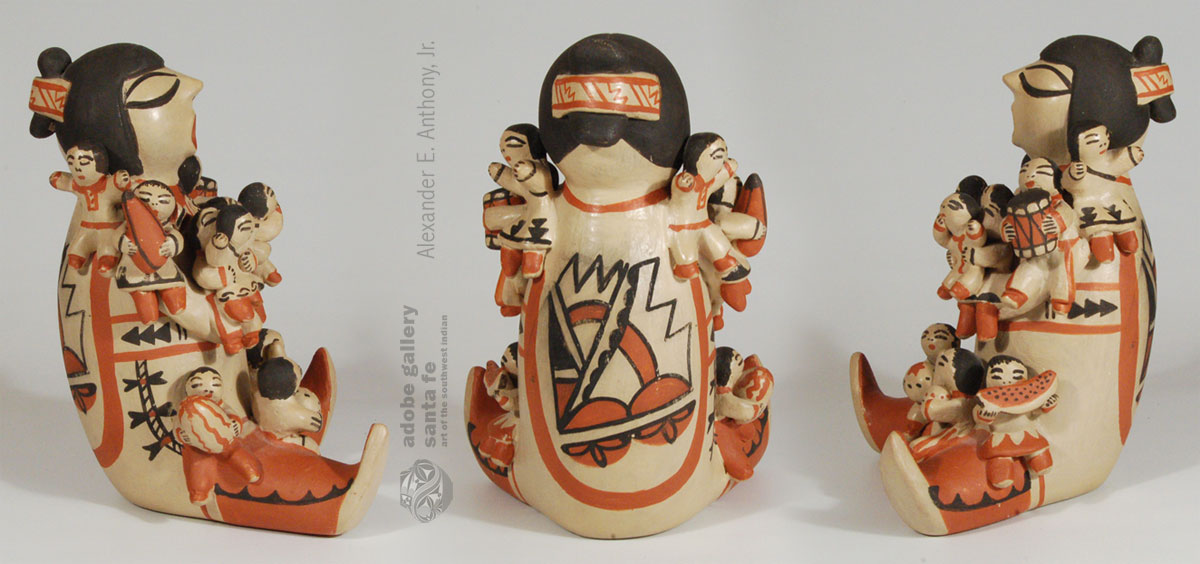Nineteenth Century Diné Very Large and Deep Basket - C4091F
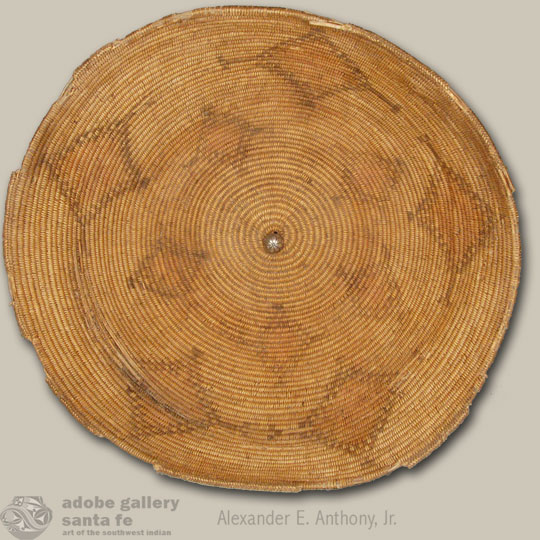 It has become common knowledge that members of the Paiute Tribe have made ceremonial baskets for the Navajo for over a hundred years. There are several reasons the Navajo turned to their northern neighbors for this favor. When the Diné were released from imprisonment by the government, they were poor and broken in spirit. From the depths of poverty and humiliation, they turned to spirituality for salvation. They developed serious ceremonial functions that required strict adherence to ritual and rules.
It has become common knowledge that members of the Paiute Tribe have made ceremonial baskets for the Navajo for over a hundred years. There are several reasons the Navajo turned to their northern neighbors for this favor. When the Diné were released from imprisonment by the government, they were poor and broken in spirit. From the depths of poverty and humiliation, they turned to spirituality for salvation. They developed serious ceremonial functions that required strict adherence to ritual and rules.
One of the items developed in conjunction with this spirituality was a "ceremonial" basket needed by the medicine man to hold sacred corn meal, prayer feathers, medicines, stirring rods, flints, claws, colored earth, and other things as part of his ceremonial bundle. Because of the importance to the ceremony of the basket, it was considered special. It was not allowed to touch the ground. The woman who made one had many restrictions placed on her. She was forbidden to have intercourse while making a basket, not allowed to be touched by anyone, kept in isolation to observe dietary restriction, could not work while menstruating, and had to undergo ceremonial cleansing before and after making a basket. Her weaving materials had to be placed so nobody would step over them. It was then that the Navajo invited the Paiutes to make ceremonial baskets for their use, as they had no such restrictions. Whiteford 1988:32
#adobegallery #NativeAmericanBasket #SouthwestIndianBaskets #Navajo #Diné #DinéBasket #NavajoBasket #SantaFeNM
Nineteenth Century Diné Very Large Basket - C4091H
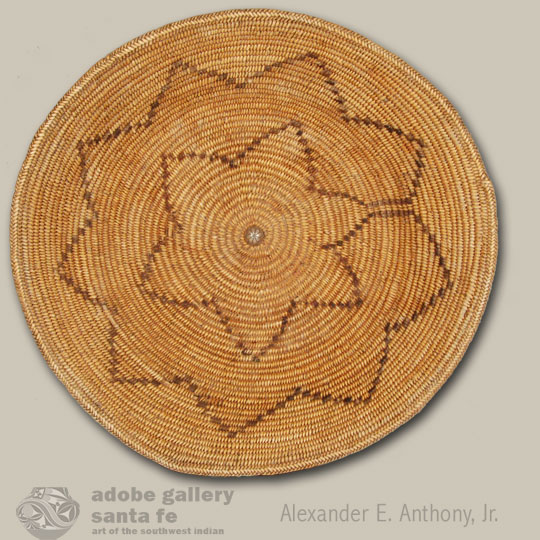 The standard wedding basket as we know it today is rare in collections of nineteenth century Navajo baskets in museums such as the Smithsonian Institution, the Field Museum of Natural History, and the Peabody Museum of Harvard University. Most of the baskets in those collections are decorated with a variety of designs, none of which is like the design of today's wedding basket. Designs such as Spider Woman crosses, spirals, whirling vanes or zigzag designs were used. There were no tribal restrictions on designs in the nineteenth century.
The standard wedding basket as we know it today is rare in collections of nineteenth century Navajo baskets in museums such as the Smithsonian Institution, the Field Museum of Natural History, and the Peabody Museum of Harvard University. Most of the baskets in those collections are decorated with a variety of designs, none of which is like the design of today's wedding basket. Designs such as Spider Woman crosses, spirals, whirling vanes or zigzag designs were used. There were no tribal restrictions on designs in the nineteenth century.
This very large basket has a design that might be called a zigzag design. Like traditional nineteenth century ones, this one is comprised of only two colors-golden color of yucca and dark brown of dyed yucca. The large star pattern at the bottom center provides the opening for the ceremonial line break as one tip of the star divides the banded pattern above. As was true then, and is still true today, the ceremonial line break is located at the point were the herringbone rim comes to an end. That is a deliberate action necessary for a medicine man to locate the ceremonial break when the basket is in use in a dark hogan during a ceremony in which the ceremonial line break must point to the east.
#adobegallery #NativeAmericanBasket #SouthwestIndianBaskets #Navajo #Diné #DinéBasket #NavajoBasket #SantaFeNM
Navajo Two Rod and Bundle Nineteenth Century Basket - C4091E
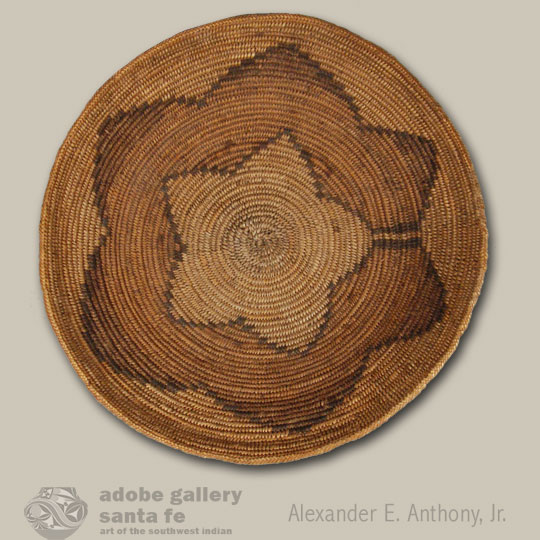 According to Andrew Hunter Whiteford, in his book Southwestern Indian Baskets Their History and Their Makers, the design on this nineteenth-century Navajo basket may be "ancestral to the classic wedding basket design, which is rare on old two-rod-and-bundle baskets." Whiteford 1988;36. His meaning is that the red zigzag band morphed into the straight-edged band now seen in the wedding baskets of today. The wedding basket design of today is rare in nineteenth-century baskets but it seems to have had its start with the design of this one.
According to Andrew Hunter Whiteford, in his book Southwestern Indian Baskets Their History and Their Makers, the design on this nineteenth-century Navajo basket may be "ancestral to the classic wedding basket design, which is rare on old two-rod-and-bundle baskets." Whiteford 1988;36. His meaning is that the red zigzag band morphed into the straight-edged band now seen in the wedding baskets of today. The wedding basket design of today is rare in nineteenth-century baskets but it seems to have had its start with the design of this one.
This Native American Basket has the same two colors seen in later wedding baskets-russet red and black- another clue to this design eventually transferring to today's wedding basket design.
![]()
#adobegallery #NativeAmericanBasket #SouthwestIndianBaskets #Navajo #Diné #DinéBasket #NavajoBasket # #SantaFeNM
Western Apache Very Large Pictorial Basket - C4082A
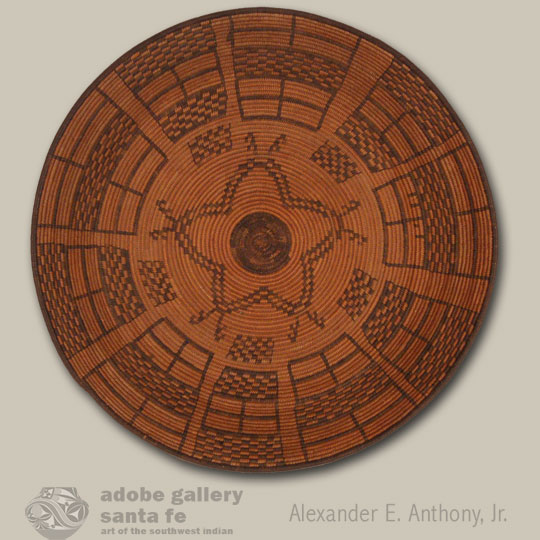 The Western Apaches were not a single tribe, but consisted of five separate and completely independent tribes-the Cibecue, San Carlos, White Mountain, and Northern and Southern Tonto. They are now considered collectively as Western Apache.
The Western Apaches were not a single tribe, but consisted of five separate and completely independent tribes-the Cibecue, San Carlos, White Mountain, and Northern and Southern Tonto. They are now considered collectively as Western Apache.
The Western Apache were of less trouble to the United States Government in the 19th century than some of the more aggressive Apache tribes. They were not displaced by the military like the more belligerent Apache of other tribes. As a result, they retained their lands and much of their culture. Their fine basketry is the best known of the Apache tribes and they are treasured by museums and collectors.
This large Native American Basket bowl likely dates to the very early 20th century and features a design that is most unusual. The large rectangular panels on the inner wall resemble windows or tall buildings.
Traditionally, and in this basket, the foundation was made from a grouping of three willow rods. They were placed so tightly together that it appears to be a single rod. The stitches also were made from willow. The black areas are of devil's claw. The brown circle of the center of the basket and the brown rim are standard and rarely change. Between these two areas, the design was from the mind of the weaver.
#adobegallery #NativeAmericanBasket #SouthwestIndianBaskets #Apache #WesternApache #Basket #PuebloBaskets #IndianBaskets #SantaFeNM
Historic Acoma Black on White design Jar with Ladle Wear Pattern - C4068W
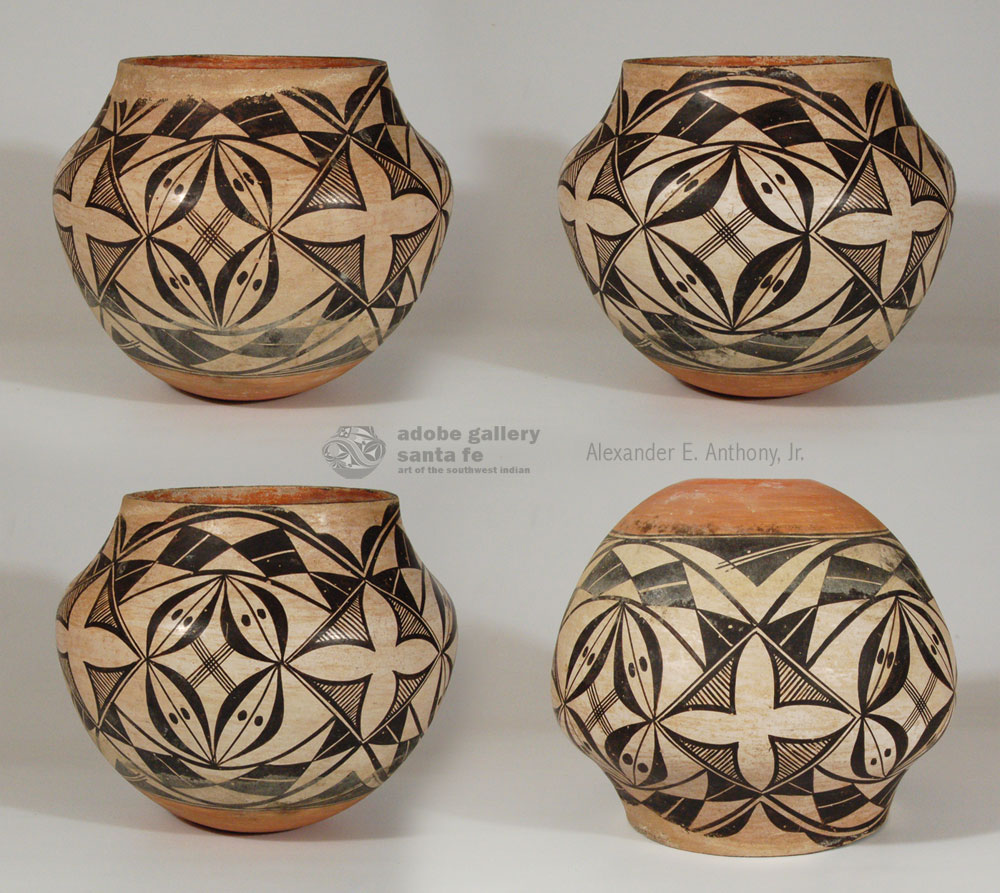 There are mixed reactions among collectors, some of whom desire pristine pottery that does not show it was ever used and others who look seriously for pottery that shows it was used at the pueblo prior to appearing on the market for sale. Fortunately there are both types available to satisfy both preferences.
There are mixed reactions among collectors, some of whom desire pristine pottery that does not show it was ever used and others who look seriously for pottery that shows it was used at the pueblo prior to appearing on the market for sale. Fortunately there are both types available to satisfy both preferences.
This Acoma Pueblo jar has significant wear to the area of the rim, evidence of many years of use as a water jar, with the handle of a ladle wearing away the painted surface and some of the clay body around the rim. Further evidence of use as a water jar is the white calcium residue on the interior of the jar and also on the exterior from water evaporation through the porous clay. This is very desirable from an historic pottery perspective.
The mid-body design consists of a chain of bold black elements that float beautifully around the body. One element consists of a square containing a clover-like blossom surrounded by parallel black lines. Another element is lighter in presentation and is a kite-like element surrounded by leaves with black dots. Over and under these alternating mid-body designs are split black diamond and triangle boxes filling the space voids. The overall result is a strong and impressive design that elevates the jar to a pleasing object of art.
#adobegallery #SouthwestIndianPottery #AcomaPueblo #AcomaPottery #PuebloPottery #SouthwestIndianArt #SantaFePottery #FinePuebloPottery #HistoricPottery
Cochiti Pueblo Traditional Storyteller Figurine by Dorothy Trujillo - C4094B
Dorothy Trujillo, who passed away in 1999, was an outstanding potter. She was originally from Jemez Pueblo, but moved to Cochiti following her marriage to Onofre Trujillo, and obtained permission to make pottery using Cochiti clay.
In true Cochiti Pueblo tradition, Dorothy made her figurine with eyes closed and mouth open. The closed eyes represent "thought" and the open mouth represents "storytelling." The adult figurine is beautifully painted with a design on the back and wearing a squash blossom necklace. There are twelve children, four on the right side, four on the left side and four on the legs. The children have a variety of items in their hands-drum, watermelon, balls, and other shapes.
#adobegallery #SouthwestIndianPottery #CochitiPueblo #CochitiPottery #PuebloPottery #SouthwestIndianArt #SantaFePottery #FinePuebloPottery #ContemporaryPottery
Historic San Ildefonso Pueblo Black on Red Small Jar - C3969D
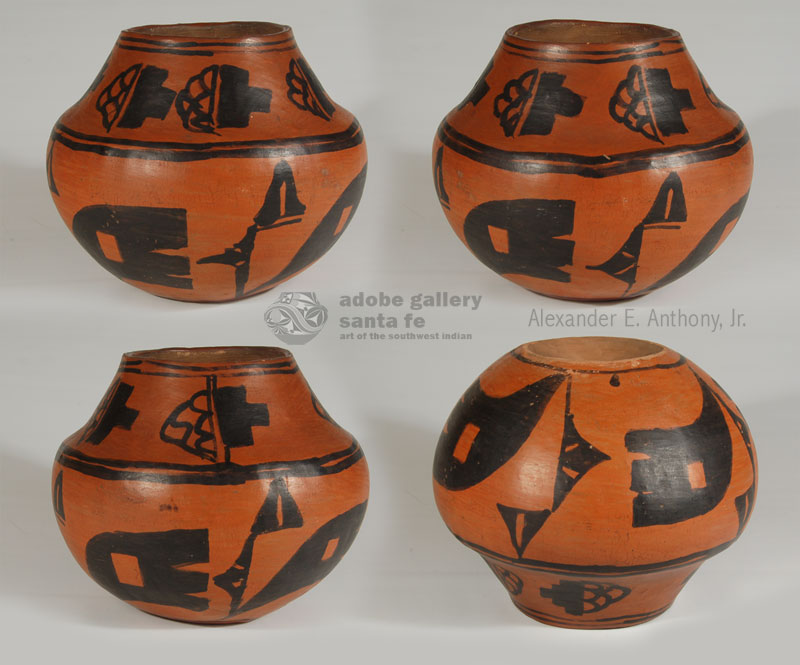 At first glance, one would suspect that this was made by Martina Vigil (1856-1916) and painted by Florentino Montoya (1858-1918) because of the large black fan emblem on the body. That emblem, with slight changes, is seen on many documented vessels by them. We have not specified that they are the artists because the painting is not as tight as Florentina normally did. It is looser in style and less perfected. It is quite possible, however, that it was one of his later efforts in the last few years of his life, but we cannot prove such.
At first glance, one would suspect that this was made by Martina Vigil (1856-1916) and painted by Florentino Montoya (1858-1918) because of the large black fan emblem on the body. That emblem, with slight changes, is seen on many documented vessels by them. We have not specified that they are the artists because the painting is not as tight as Florentina normally did. It is looser in style and less perfected. It is quite possible, however, that it was one of his later efforts in the last few years of his life, but we cannot prove such.
The jar is traditional to San Ildefonso, as are the designs. It probably dates to 1910-15, a period that would agree with Florentina's last years.
#adobegallery #SouthwestIndianPottery #SanIldefonsoPueblo #SanIldefonsoPottery #PuebloPottery #SouthwestIndianArt #SantaFePottery #FinePuebloPottery #HistoricPottery
Zia Pueblo Olla with Birds Framed within Hachured Triangles - C4092
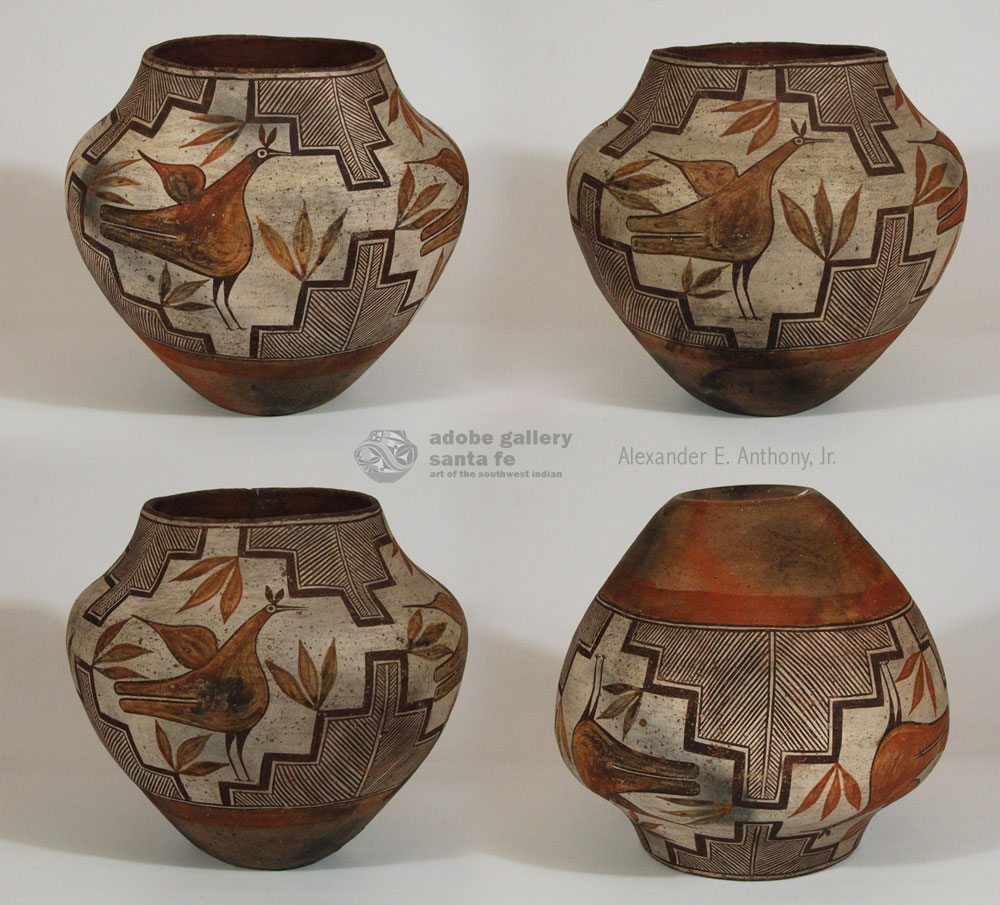 It is a common expectation to see a Zia bird featured on an OLLA, usually surrounded by floral elements, but the exuberance of the hachured lines on this jar take precedence over the bird. Hachure designs at Zia came from Zuni Pueblo, probably as early as 1880. This adoption of designs from one pueblo to another increased at that time due to the movement of people through marriage or other reasons. The arrival of the passenger train in New Mexico in 1879 provided more opportunities for potters to make wares for sale and the movement of artists from pueblo to pueblo became more frequent.
It is a common expectation to see a Zia bird featured on an OLLA, usually surrounded by floral elements, but the exuberance of the hachured lines on this jar take precedence over the bird. Hachure designs at Zia came from Zuni Pueblo, probably as early as 1880. This adoption of designs from one pueblo to another increased at that time due to the movement of people through marriage or other reasons. The arrival of the passenger train in New Mexico in 1879 provided more opportunities for potters to make wares for sale and the movement of artists from pueblo to pueblo became more frequent.
The fine line hachured elements, outlined in a narrow and wide band is a direct import from Zuni pottery from the Zuni Rain Bird design. In this Zia interpretation, the triangular-shaped boundaries are more structured and fixed than the Zuni Rain Bird design that has hooks and bends. This Zia hachure design facilitates dating this jar to the late 1800s.
#adobegallery #SouthwestIndianPottery #ZiaPueblo #ZiaPottery #PuebloPottery #SouthwestIndianArt #SantaFePottery #FinePuebloPottery #HistoricPottery
Kewa Pueblo Turquoise Nugget and White Shell Necklace - C4072F
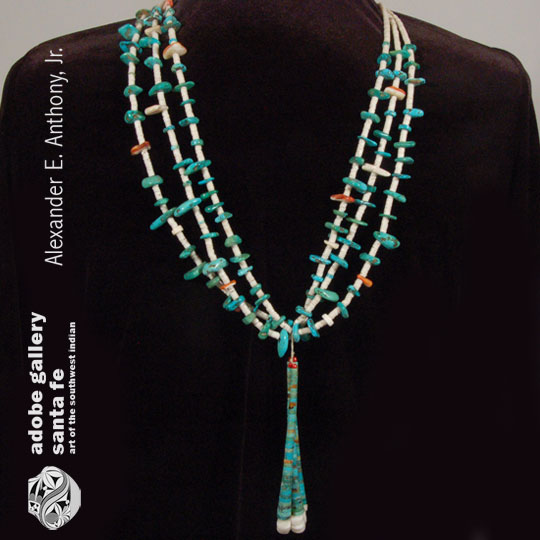 This style necklace is centuries old. Archaeologists discovered caches of turquoise and shell necklaces at Chaco Canyon, evidence that the ancestors of today's Pueblo people were using turquoise nuggets and shell as items of adornment over one thousand years ago. And from the earliest of times, turquoise has been favored by the Pueblo Indians of the Southwest. They mined it at Cerrillos, about 30 miles south of Santa Fe, for centuries. Turquoise had religious, ceremonial, superstitious and economic values to the Pueblo Indians.
This style necklace is centuries old. Archaeologists discovered caches of turquoise and shell necklaces at Chaco Canyon, evidence that the ancestors of today's Pueblo people were using turquoise nuggets and shell as items of adornment over one thousand years ago. And from the earliest of times, turquoise has been favored by the Pueblo Indians of the Southwest. They mined it at Cerrillos, about 30 miles south of Santa Fe, for centuries. Turquoise had religious, ceremonial, superstitious and economic values to the Pueblo Indians.
Bits of turquoise were put in bearing beams of buildings to strengthen them, offerings of turquoise were made at sacred shrines, medicine men used it in diagnostic and healing rituals, and it was often used in burials. It is a unique sign of wealth and is seen in abundance at ceremonial dances at the pueblos of New Mexico. Hieshe, made from seashells, such as used in this necklace, is constructed in a most interesting manner. The shell is cut into small pieces, drilled and strung on cotton string, then slowly and meticulously rolled over sandstone until each piece is round and all the pieces are of the same diameter or graduated diameter, if desired. Cotton is used because it is softer and doesn't wear against the shell too abrasively. The turquoise tabs that are added to such a hieshe necklace are drilled, often off center, and strung with the hieshe to form an interesting necklace.
#adobegallery #SouthwestIndianJewelry #SantaFeJewelry #KewaPueblo #SantoDomingoPueblo #Jewelry #SantaFeJewelry #SouthwestPuebloJewelry #Necklace
Historic Kewa - Santo Domingo Pueblo Tall Water Jar - C3551D
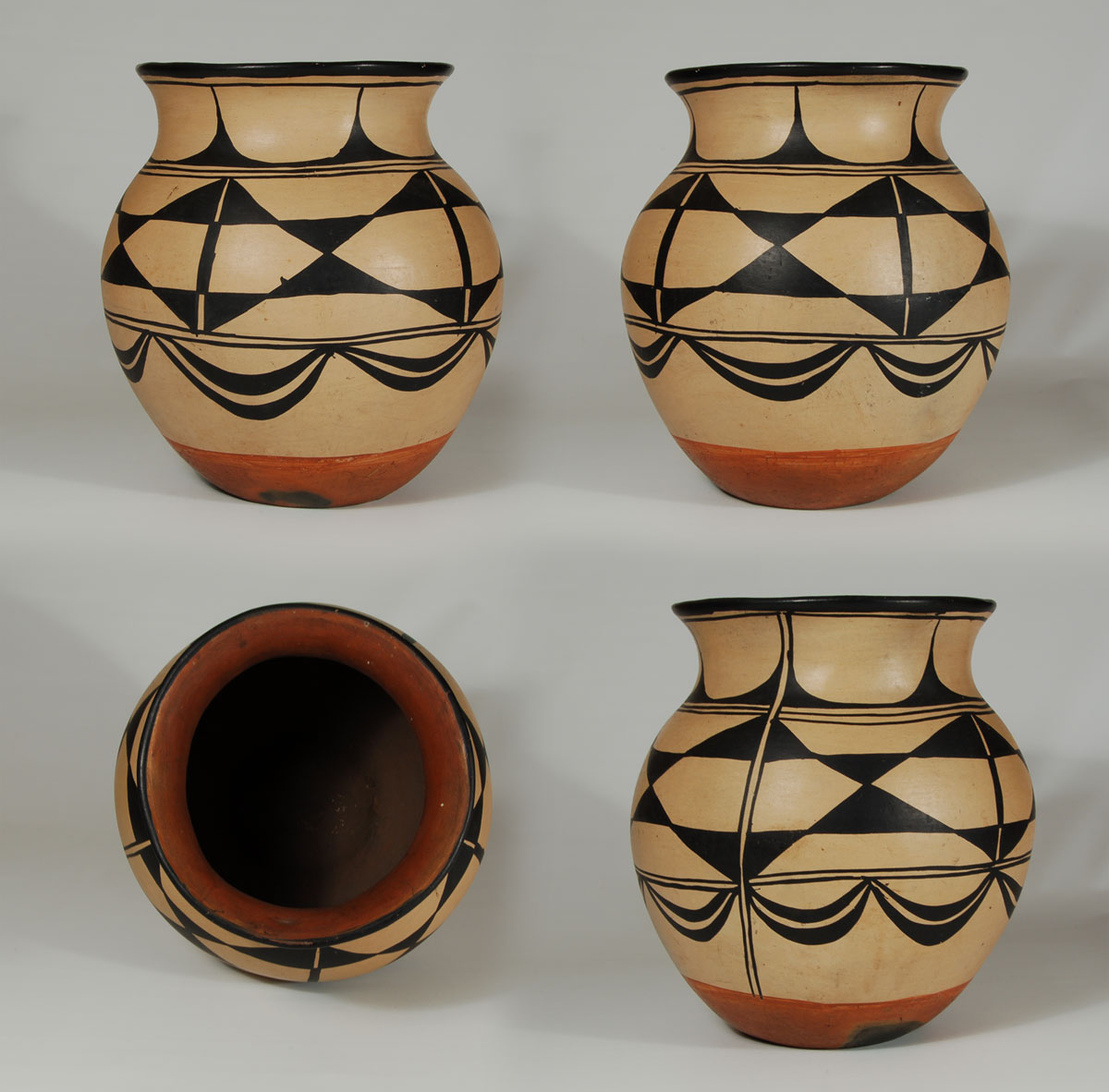 This is a very traditional Kewa (Santo Domingo) Pueblo polychrome olla, probably from the 1930s, with traditional rag-wiped bentonite slip, black rim around the top, black framing line just below the rim, black double framing lines just under the neck and another pair just below the mid-body. All the framing lines incorporate ceremonial breaks.
This is a very traditional Kewa (Santo Domingo) Pueblo polychrome olla, probably from the 1930s, with traditional rag-wiped bentonite slip, black rim around the top, black framing line just below the rim, black double framing lines just under the neck and another pair just below the mid-body. All the framing lines incorporate ceremonial breaks.
The main body is decorated in extremely bold design elements-strong black triangles back to back. Suspended from the lower framing lines are pairs of arcs as if draped from the lower line. The interior neck has been rag wiped with red slip, and the underbody below the design field has been wiped with a red slip. The underside is concave.
#adobegallery #SouthwestIndianPottery #KewaPueblo #KewaPottery #PuebloPottery #SouthwestIndianArt #SantaFePottery #FinePuebloPottery #HistoricPottery
Akimel O'odham - Pima Polychrome Basket Bowl - C4082C
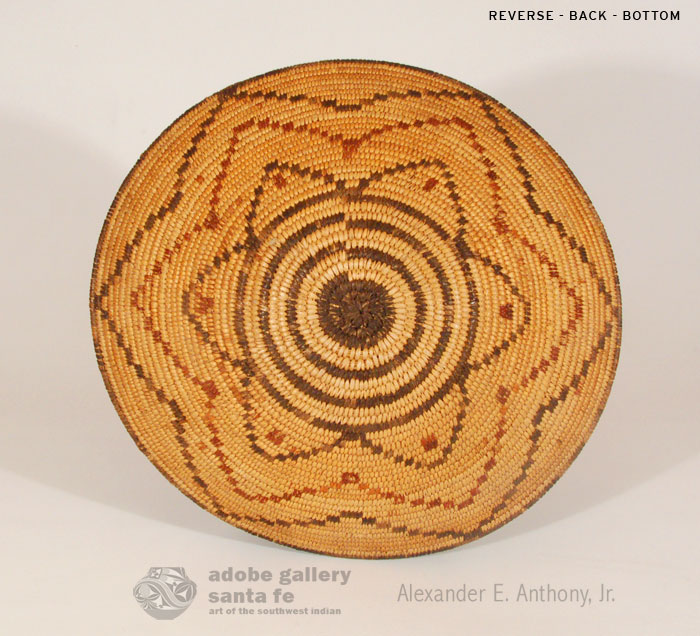 There is similarity between the older Pima, Papago, and Apache basketry. Sometimes it is difficult to determine the origin simply by looking at the design or the rim stitching, however, materials used are a defining factor.
There is similarity between the older Pima, Papago, and Apache basketry. Sometimes it is difficult to determine the origin simply by looking at the design or the rim stitching, however, materials used are a defining factor.
Pima basketmakers used grass-like materials for the foundation-such as cattail stems, wheat-straw, or sometimes arrowbush. Apache basketmakers used a single rod, usually willow, for the foundation, providing a more rigid basket than those with a grass foundation. The Papago used materials similar to those used by the Pima, but the stitching and rim coils differ between the two tribes.
This basket, at first glance, would appear to be Western Apache, however, the grass foundation materials identify is as Pima. The beginning coils in the bottom were stitched with devil's claw, as were the other single zigzag black lines. The red design was executed with split peel yucca root. The golden tone weave is of willow. The basket dates to the 1920s.
#adobegallery #NativeAmericanBasket #SouthwestIndianBaskets #AkimelOodhamBaskets #PimaBaskets #SantaFeNM #IndianBaskets
Historic Kewa Pueblo Historic Deep Dough Bowl - C3924J
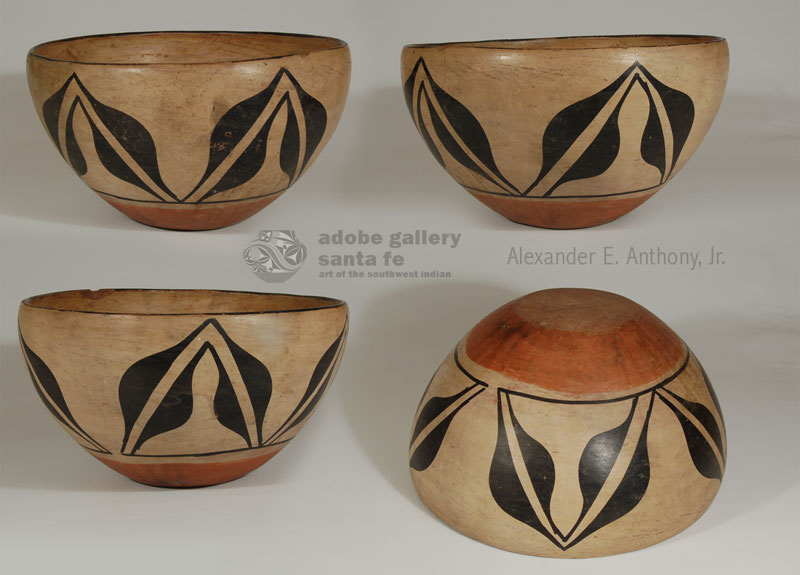 Dough bowls come in various sizes, depending on their intended use. Some are very large-17 inches or more-for those times when bread is being prepared for large crowds at feast days; smaller ones-12 inches or less-for those days when just a few loaves are being prepared. This dough bowl is of the smaller size. The advantage of smaller ones like this is that they can be used for serving food or other functions when not in use for letting the dough rise.
Dough bowls come in various sizes, depending on their intended use. Some are very large-17 inches or more-for those times when bread is being prepared for large crowds at feast days; smaller ones-12 inches or less-for those days when just a few loaves are being prepared. This dough bowl is of the smaller size. The advantage of smaller ones like this is that they can be used for serving food or other functions when not in use for letting the dough rise.
This bowl features a creative and unusual design in which a potter expressed her artistic abilities rather than apply the same design seen on so many bowls of the period. The bowl has a polished cream skip on the interior and exterior, both of which have acquired an aged and warm patina, suggesting that the bowl is approaching a hundred years of age.
#adobegallery #SouthwestIndianPottery #KewaPueblo #KewaPottery #PuebloPottery #SouthwestIndianArt #SantaFePottery #FinePuebloPottery #HistoricPottery
Hopi-Tewa Pueblo Black on Red Small Bowl - C4078J
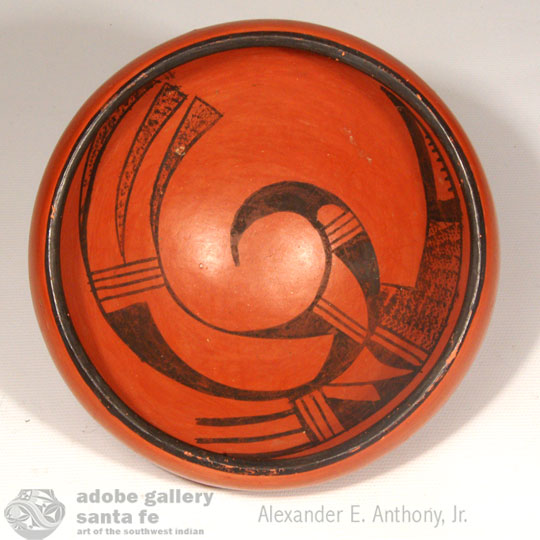 In the early 1900s, both Nampeyo and her daughter, Annie, made black-on-red pottery. Annie is credited with outlining some of the design with white occasionally. How many other potters made similar styles is not known. Examples have been documented by Evelyn Poolheco, Sadie Adams, Emogene Lomakema, Nellie Nampeyo, Lena Chino Charlie, and other contemporary potters, so it is difficult to make an attribution when one is not signed. This small bowl has the name Paquawritten in pencil but it is doubtful that it was written by the potter but most likely some someone making an attribution. Paqua, of course, was the first Frog Woman.
In the early 1900s, both Nampeyo and her daughter, Annie, made black-on-red pottery. Annie is credited with outlining some of the design with white occasionally. How many other potters made similar styles is not known. Examples have been documented by Evelyn Poolheco, Sadie Adams, Emogene Lomakema, Nellie Nampeyo, Lena Chino Charlie, and other contemporary potters, so it is difficult to make an attribution when one is not signed. This small bowl has the name Paquawritten in pencil but it is doubtful that it was written by the potter but most likely some someone making an attribution. Paqua, of course, was the first Frog Woman.
#adobegallery #SouthwestIndianPottery #HopiPueblo #HopiPottery #PuebloPottery #SouthwestIndianArt #SantaFePottery #FinePuebloPottery #ContemporaryPottery
Historic Laguna Pueblo Black on White Design Olla - C4068J
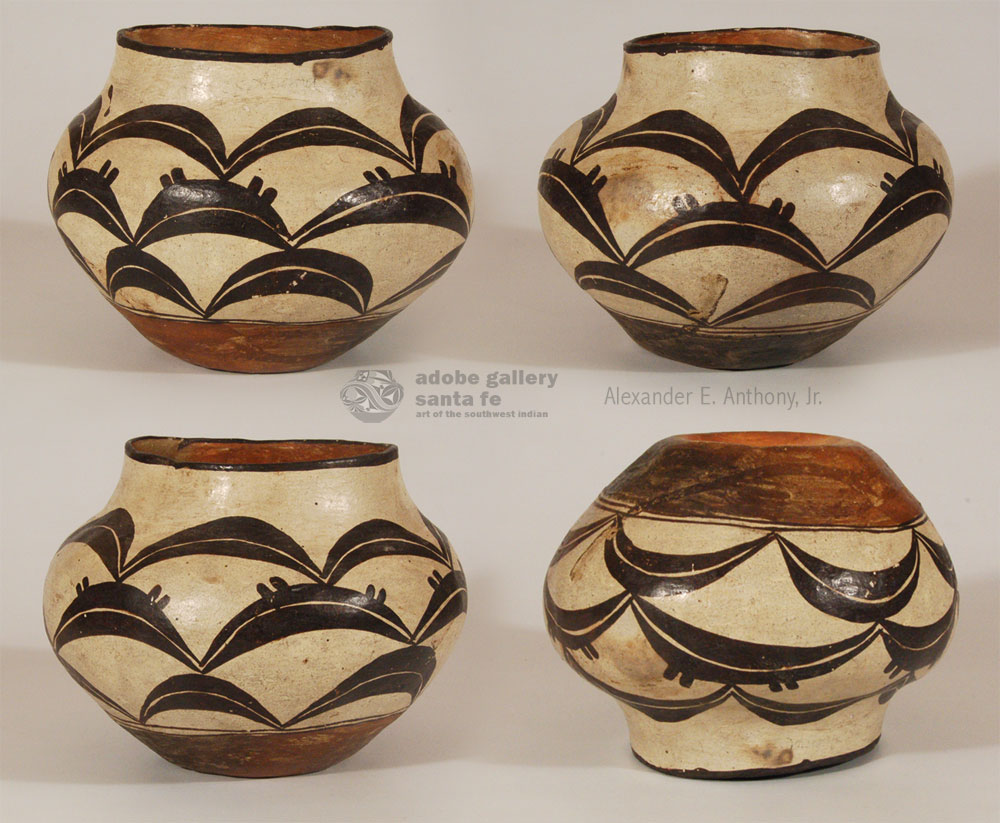 This is an historic child-size water jar that is believed to date to circa 1880s. It has a warm cream slip over which are designs in dark brown pigment. The boldness of the design and the openness of its arrangement strongly lean to an origin of Laguna Pueblo. The stacked arches are split through their centers, another trait of Laguna Pueblo, usually seen as "split leaf" designs but in this case interpreted as stacked rain clouds. The underbody is concave and orange in color and a red band was placed on the interior of the rim.
This is an historic child-size water jar that is believed to date to circa 1880s. It has a warm cream slip over which are designs in dark brown pigment. The boldness of the design and the openness of its arrangement strongly lean to an origin of Laguna Pueblo. The stacked arches are split through their centers, another trait of Laguna Pueblo, usually seen as "split leaf" designs but in this case interpreted as stacked rain clouds. The underbody is concave and orange in color and a red band was placed on the interior of the rim.
We have chosen to identify this as having originated at Laguna Pueblo primarily based on the size and design of the vessel. Also, the Atchison, Topeka and Santa Fe Railway line had a daily stop at Laguna Pueblo to allow tourists to take a break, get off the train, and purchase souvenirs from the potters. A vessel of this size and shape was certainly more attuned to the tourist trade than to pueblo use.
#adobegallery #SouthwestIndianPottery #LagunaPueblo #LagunaPottery #PuebloPottery #SouthwestIndianArt #SantaFePottery #FinePuebloPottery #HistoricPottery
Historic Acoma Pueblo Black on White Tularosa Design Jar - C4068S
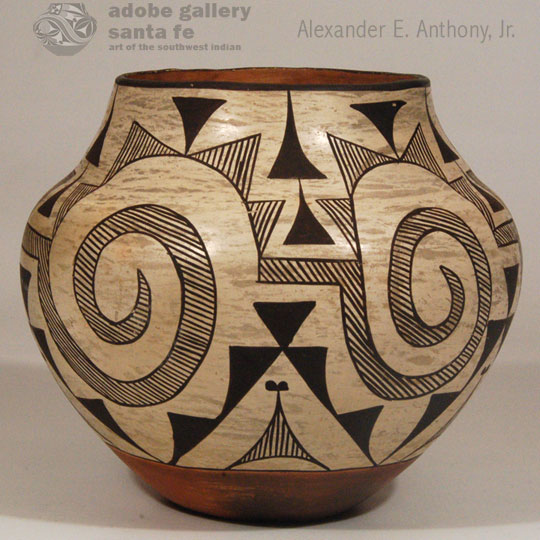 Although this is a 20th century Acoma Pueblo jar, it is decorated with what has been designated as "Tularosa Black-on-white." Acoma potters were impressed with prehistoric pottery designs and began reintroducing them in the early twentieth century.
Although this is a 20th century Acoma Pueblo jar, it is decorated with what has been designated as "Tularosa Black-on-white." Acoma potters were impressed with prehistoric pottery designs and began reintroducing them in the early twentieth century.
Typology names used on pottery found in the Southwest were established at a conference of archaeologists held at Gila Pueblo in Arizona in 1930. "There, scholars worked out a system of nomenclature for classifying the ceramic types they were finding in the Southwest. The system enabled them to classify broken pieces of pottery, or sherds, and whole vessels. Based on designations for various kinds of prehistoric pottery, the system is used for historic pottery as well.
#adobegallery #SouthwestIndianPottery #AcomaPueblo #AcomaPottery #PuebloPottery #SouthwestIndianArt #SantaFePottery #FinePuebloPottery #HistoricPottery
Historic Ohkay Owingeh Pueblo Red over Tan Dough Bowl - 26103
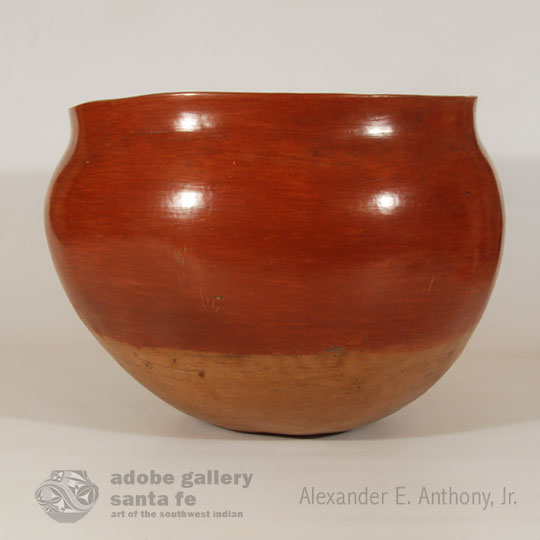 This vessel might be called a dough bowl or a storage jar, depending on its use. It is typical of traditional San Juan Pueblo (now known as Ohkay Owingeh) Red-on-tan typology and dates from c1900. The upper two-thirds of the vessel is covered in highly stone-polished red slip over the basic tan vessel and the lower third remains a stone-polished natural clay body. The interior was stone polished to the natural tan clay body to act as sealant of the natural clay.
This vessel might be called a dough bowl or a storage jar, depending on its use. It is typical of traditional San Juan Pueblo (now known as Ohkay Owingeh) Red-on-tan typology and dates from c1900. The upper two-thirds of the vessel is covered in highly stone-polished red slip over the basic tan vessel and the lower third remains a stone-polished natural clay body. The interior was stone polished to the natural tan clay body to act as sealant of the natural clay.
The vessel was fired outdoors, but is devoid of any fire clouds. The walls flare outward just so slightly and upward, then curve inward before rolling out again just slightly at the neck. The bowl has a beautiful globular shape with the widest diameter just above midpoint and a short graceful outwardly curving neck.
#adobegallery #SouthwestIndianPottery #OhkayOwingehPueblo #OhkayOwingehPottery #PuebloPottery #SouthwestIndianArt #SantaFePottery #FinePuebloPottery #HistoricPottery
Akimel O' Odham - Pima Basket with Whirling Log Design - C4082D
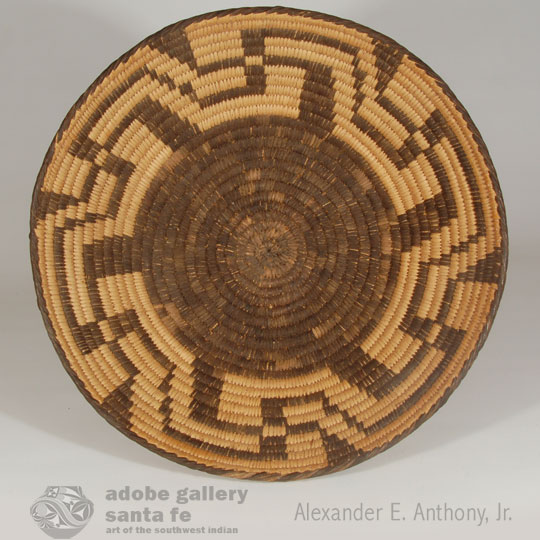 O'odham, a name applied to the Arizona tribes previously known as Papago and Pima, is a Uto-Aztecan language group of southern Arizona and northern Sonora, Mexico, where the Tohono O'odham (formerly called the Papago) and Akimel O'odham (traditionally called Pima) reside. The members of the two tribes made baskets which were very much alike in earlier years, both using willow and devil's claw (martynia) for decorative material. Although their baskets may look similar, they are quite different. Pima baskets are much more related to Apache baskets than to Papago ones.
O'odham, a name applied to the Arizona tribes previously known as Papago and Pima, is a Uto-Aztecan language group of southern Arizona and northern Sonora, Mexico, where the Tohono O'odham (formerly called the Papago) and Akimel O'odham (traditionally called Pima) reside. The members of the two tribes made baskets which were very much alike in earlier years, both using willow and devil's claw (martynia) for decorative material. Although their baskets may look similar, they are quite different. Pima baskets are much more related to Apache baskets than to Papago ones.
Pima baskets generally feature a black center bottom that then branches out and up to the intended design. In this basket, the meandering design, when examined closely, resembles a swastika or whirling log. This design was generally eliminated in the pre-World War II period of the late 1930s when it was adopted by the Nazi regime.
#adobegallery #NativeAmericanBasket #SouthwestIndianBaskets #AkimelOodhamBaskets #PimaBaskets #SantaFeNM #IndianBaskets
Zuni Pueblo Silver and Turquoise Channel Inlay Ring - C4070M
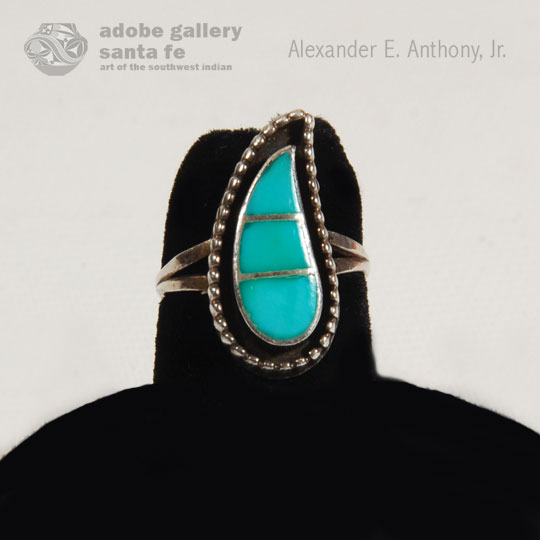 The distinctive style of Willis and Susie Leekity is apparent in this small teardrop shaped channel inlay ring. The couple meticulously cut and shaped three small pieces of Sleeping Beauty turquoise and placed them in sterling silver channels which was then set in a handmade bezel. It is framed within a band of twisted wire. Although the piece is unsigned, it is definitely the style of Willis and Susie Leekity.
The distinctive style of Willis and Susie Leekity is apparent in this small teardrop shaped channel inlay ring. The couple meticulously cut and shaped three small pieces of Sleeping Beauty turquoise and placed them in sterling silver channels which was then set in a handmade bezel. It is framed within a band of twisted wire. Although the piece is unsigned, it is definitely the style of Willis and Susie Leekity.
#adobegallery #SouthwestIndianJewelry #NativeAmericanJewelry #ZuniJewelry #ZuniPueblo #Silver #Turquoise #ZuniJewelry #SantaFeJewelry #ZuniSliversmith
Acoma Polychrome Large Parrot Jar by Barbara and Joe Cerno - C4080C
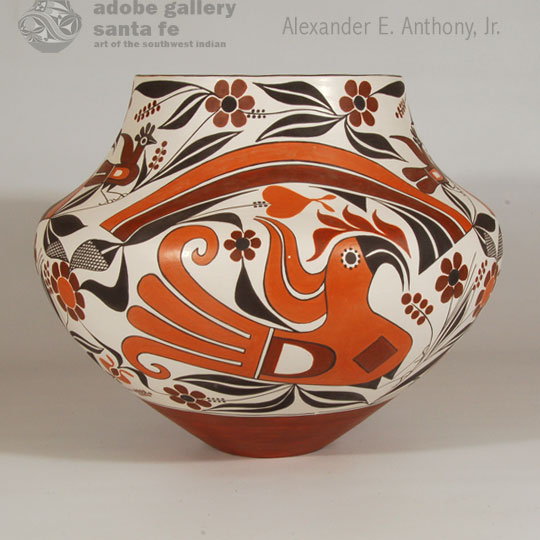 Barbara and Joe Cerno, Sr. are a husband and wife pottery-making team. One of their hallmark designs is the combination of parrots and flowers. In this large OLLA or jar, the design was executed in three repeated elements, each of a parrot clutching the twig of a flower. The design was executed in four colors-orange, deep red, black and white. The designs are continuous from the underbody up to the rim without a break in continuity.
Barbara and Joe Cerno, Sr. are a husband and wife pottery-making team. One of their hallmark designs is the combination of parrots and flowers. In this large OLLA or jar, the design was executed in three repeated elements, each of a parrot clutching the twig of a flower. The design was executed in four colors-orange, deep red, black and white. The designs are continuous from the underbody up to the rim without a break in continuity.
The traditional Acoma Pueblo vessel shape is widest at midpoint and curves inward and extends up to the rim. As is traditional at Acoma, the design covers almost every square inch of the jar. There are budding flowers at the ends of stems and there are black split-leaf petals. In addition to the three large parrots, there are three smaller birds clasping the stems of plants with their eyes focused on the attached berries. Over each parrot is a double rainbow, expressed in two colors.
#adobegallery #SouthwestIndianPottery #AcomaPueblo #AcomaPottery #PuebloPottery #SouthwestIndianArt #SantaFePottery #FinePuebloPottery #ContemporaryPottery # BarbaraandJoeCerno
Acoma Polychrome Parrot Design Wedding Vessel by Lucy Lewis - C4080D
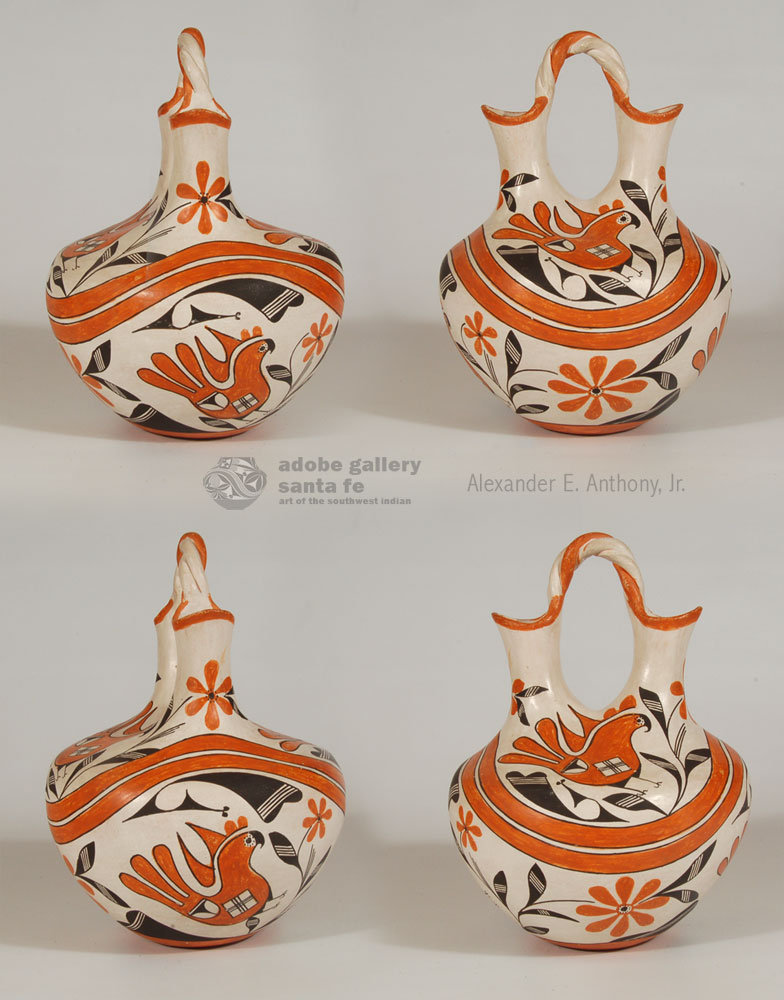 Travelers to New Mexico who have been to Acoma Pueblo are familiar with the original village atop the mesa known today as Sky City. It was on top of that mesa in 1898 that Lucy Martin Lewis was born and it was there that she grew up without the benefit of going to school. It was there also that she was struck by lightning in the 1960s. There was little hope that she would ever work again, but with perseverance she regained her muscle strength and went on to become one of the most recognized potters at Acoma Pueblo.
Travelers to New Mexico who have been to Acoma Pueblo are familiar with the original village atop the mesa known today as Sky City. It was on top of that mesa in 1898 that Lucy Martin Lewis was born and it was there that she grew up without the benefit of going to school. It was there also that she was struck by lightning in the 1960s. There was little hope that she would ever work again, but with perseverance she regained her muscle strength and went on to become one of the most recognized potters at Acoma Pueblo.
Famous photographer Laura Gilpin took Lucy Lewis to Santa Fe in 1958 to meet Dr. Kenneth Chapman, then the director of the New Mexico Museum. Chapman had been an influence on Maria and Julian Martinez in the 1920s. Now he would influence Lucy Lewis by showing her examples of ancient pottery that were her heritage. Lewis adopted many of these designs and used them throughout her life.
#adobegallery #SouthwestIndianPottery #AcomaPueblo #AcomaPottery #PuebloPottery #SouthwestIndianArt #SantaFePottery #FinePuebloPottery #ContemporaryPottery #LucyLewis


